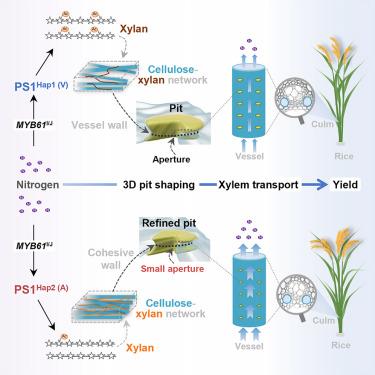管壁凹陷结构的形成维持木质部水力学和籽粒产量
IF 42.5
1区 生物学
Q1 BIOCHEMISTRY & MOLECULAR BIOLOGY
引用次数: 0
摘要
植物已经进化出了一个管道系统,具有加固的墙壁和创新的墙壁结构,以确保水和营养物质的有效运输。导管坑是导管壁上细小的三维空腔,是植物水力学和生长塑性的关键决定因素。然而,它们的超微结构和形成机制尚不清楚。在这里,我们揭示了凹坑的纳米级三维结构以及介导凹坑形成和维持木质部坚固性和籽粒产量的分子途径。水稻核坑大小的一个数量性状位点(PS1)是一种控制核坑几何形状的木聚糖去乙酰化酶。一个优秀的PS1等位基因将木聚糖修饰为低乙酰化状态,促进它们与纤维素的结合并保持坑边界周围的壁一致性。优良的单倍型使水稻品种具有更高的氮转运能力和产量。因此,我们发现了一种提高木质部水力学和作物产量的分子途径,为可持续农业提供了一种有前途的策略。本文章由计算机程序翻译,如有差异,请以英文原文为准。

Shaping pit structure in vessel walls sustains xylem hydraulics and grain yield
Plants have evolved a conduit system with reinforced walls and innovative wall structures that ensure efficient transport of water and nutrients. Vessel pits, fine three-dimensional (3D) cavities in conduit walls, are key determinants of plant hydraulics and growth plasticity. However, their ultrastructure and formation mechanisms are unknown. Here, we reveal the nanoscale 3D structure of pits and the molecular pathway that mediates pit shaping and sustains xylem robustness and grain yield. A quantitative trait locus for pit size (PS1), identified by a genome-wide association study in rice, is a xylan deacetylase that controls pit geometry. An elite PS1 allele modifies xylans to a hypoacetylated state, facilitating their binding to cellulose and maintaining wall coherence around pit boundaries. The elite haplotypes confer rice varieties with enhanced nitrogen transport and grain yield. We thus discover a molecular pathway that boosts xylem hydraulics and crop yield, offering a promising strategy for sustainable agriculture.
求助全文
通过发布文献求助,成功后即可免费获取论文全文。
去求助
来源期刊

Cell
生物-生化与分子生物学
CiteScore
110.00
自引率
0.80%
发文量
396
审稿时长
2 months
期刊介绍:
Cells is an international, peer-reviewed, open access journal that focuses on cell biology, molecular biology, and biophysics. It is affiliated with several societies, including the Spanish Society for Biochemistry and Molecular Biology (SEBBM), Nordic Autophagy Society (NAS), Spanish Society of Hematology and Hemotherapy (SEHH), and Society for Regenerative Medicine (Russian Federation) (RPO).
The journal publishes research findings of significant importance in various areas of experimental biology, such as cell biology, molecular biology, neuroscience, immunology, virology, microbiology, cancer, human genetics, systems biology, signaling, and disease mechanisms and therapeutics. The primary criterion for considering papers is whether the results contribute to significant conceptual advances or raise thought-provoking questions and hypotheses related to interesting and important biological inquiries.
In addition to primary research articles presented in four formats, Cells also features review and opinion articles in its "leading edge" section, discussing recent research advancements and topics of interest to its wide readership.
 求助内容:
求助内容: 应助结果提醒方式:
应助结果提醒方式:


